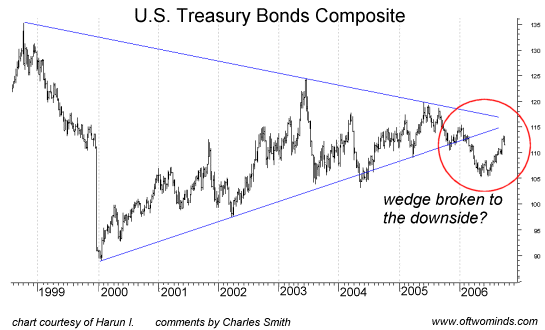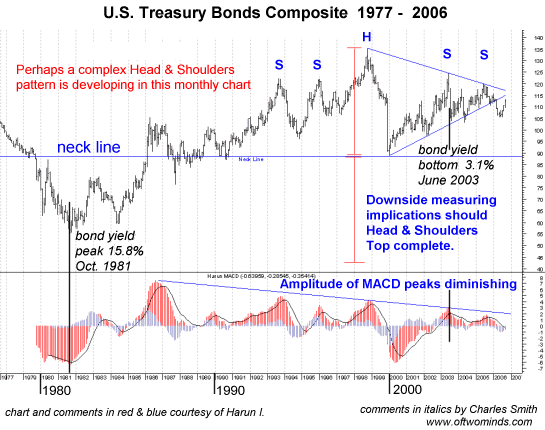

|
| weblog/wEssays archives | home | |
|
Getting Bond Yields (and interest rates) Right (October 17, 2006) Yesterday I presented the essentials of what you need to know about the coming oil shortage. Please don't make up your mind on the topic until you've read the interview and the two books I provided. The facts are not as sanguine as the rah-rah crowd would have you believe. Just one factoid I have referenced in previous entries. Those Canadian tar sands which are our supposed "unlimited" energy savior? 1. We use 23 million barrels a day of crude oil. The maximum practical output of the Canadian tar sands complex is about 3 million barrels a day--1/3 of which is spoken for by the Chinese. So at best, we (the Canadians willing, of course) might draw less than 10% of our needs from the vaunted tar sands. 2. Mining and processing the gunk is horrendously costly and burns vast quantities of natural gas. It is not an efficient extraction of energy. 3. Mining and processing the gook creates environmental problems on a truly stupendous scale. I could go on and on but instead, why not just read the darn books? Ignorance is no substitute for knowledge, especially when it comes to investing. 
Today, let's look at the long-term direction of U.S. Treasury bond yields--the thing which ultimately sets mortgage and interest rates. Thanks yet again to frequent contributor Harun I., we have two fascinating charts to consider. At the risk of boring you financially savvy readers, let's cover a few basic realities of the Treasury bond market: 1. The Federal Reserve does not set mortgage rates or long-term interest rates; market forces of supply and demand set those rates. If global buyers willingly snap up all our bonds at 4% yield, then the Treasury doesn't need to raise the yield rates, and mortgage rates stay low, too. But if buyers stop buying bonds which yield 4%, the Treasury must raise the yield until buyers emerge. 2. Our government runs a massive deficit which must be funded by selling bonds. There is no Plan B, i.e. another source of funds to cover the deficit. Not only that, but there's over $4 trillion in existing debt which has to be constantly re-financed. The net result: our government must sell billions of bonds each and every month. If there is no buyer, the yield must rise. 3. The value of the bond is inverse to the yield. If interest rates jump 50%, the value of an existing bond drops 50%. Conversely, if interest rates plummet, the value of an existing bond rises. The reason is simple: why buy an existing bond that pays 5% when you can buy a new bond which pays 7.5%? 4. We as a nation have long been heavily dependent on foreign banks and entities buying up our debt/Treasury bonds. This makes us extraordinarily vulernable to political or financial changes in overseas appetites and willingness to buy U.S. Treasury bonds. This chart of the U.S. Treasury Bond Composite shows a massive wedge. As readers have gleaned from previous posts on the bond and on gold, wedges tend to break up or down in a major fashion. The recent action in this chart suggests the wedge has broken to the downside, i.e. the bond yield will continue rising in a long-term trend. What are the implications for a rising bond yield? Well, one is that mortgage rates will continue rising, effectively gutting what remains of the "housing boom." (More on that tomorrow.) If you're still a believer in the rah-rah cheerleaders' prediction that interest rates are going down and housing has hit bottom, check your enthusiasm at the door and consider this chart: 
Here is the wedge is a long-term perspective. As Harun notes, this could well be a "head and shoulders" formation, which in technical analysis is a pattern commonly found at a market top. He also observes that if this is the top, there are technical reasons for projecting a bottom which exceeds the previous low of October 1981, when yields hit 16%. The implication of this chart is rather profound: not only could interest rates rise, but there is the potential for the yield to exceed the previous high of 16%. For readers who are too young to remember the recession triggered by yields (and thus interest rates) rising to 16%, here is a synopsis: 1. The auto and housing industries were gutted, as no one could afford to borrow money. GM laid off 100,000 workers in one weekend. 2. Unemployment rose to over 10% officially; unofficially, i.e. counting all those who dropped off the statistical count after 6 months, it was on the order of 15%. 3. The stock and bond markets plummeted, as stocks could not compete with a 16% risk-free yield on plain old cash. The value of lower-yield existing bonds fell to the basement, wiping out much of the holders "safe investment." "That couldn't happen again." Oh really? Exactly why? The dollar and the bond are both perched rather precariously on the backs of the Chinese, Japanese and OPEC banks/investors. Should events conspire to weaken their desire to hold bonds (and thus the dollar), the yield would jump overnight. But wouldn't red-blooded Americans step up and buy trillions in Treasury bonds? Hahahahaha... with what cash? We have a negative savings rate! Would you suggest liquidating real estate to raise money... just as real estate dives in value? What would additional inventory do to prices? How about stocks? What would liquidating $2 trillion in stocks (to raise cash) do to the stock market valuations, especially if they're already dropping under pressure from a rising yield? And why buy a 30-year bond yielding 6% if it appears you could get 7% next month or even next year? A nightmare scenario, to be sure, but not out of the realm of possibility. As Harun noted: "I make no predictions; I follow the trend." Readers, please look carefully at the charts above before deciding interest rates "can only drop." For more on this subject and a wide array of other topics, please visit my weblog. copyright © 2006 Charles Hugh Smith. All rights reserved in all media. I would be honored if you linked this wEssay to your site, or printed a copy for your own use. |
||
| weblog/wEssays | home |